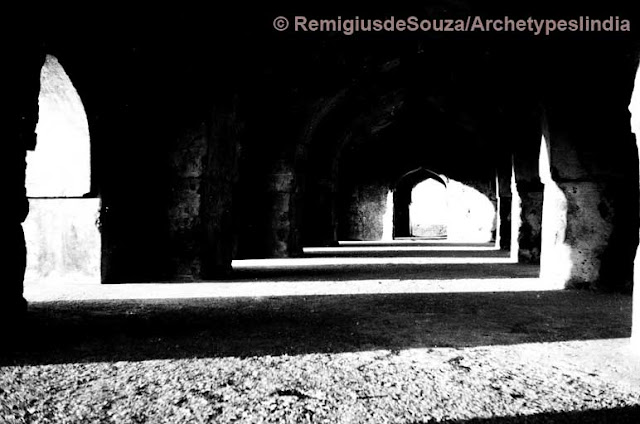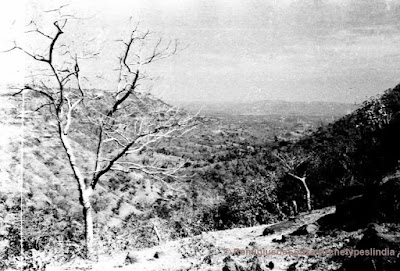The Great Mosque as Place in Public Domain
...in the then existing kingdom. I looked at it before, and now too, as a citizen first and as a 'worker' to earn livelihood in architecture and town planning, once.
In the realms of Ethics and Aesthetics, whenever I look at it, this edifice as an event overwhelms me.
In the realms of Environment - Ecology - Energy in Nature and Life, I have yet to reconstruct it as then existed.
The NOW, however, exists as remains of history before us. Could we reconstruct with the missing elements, in Holistic Way?
The following snippets in photos and notes are a Virtual Reality, with many speaking blank spaces!
In the realms of Environment - Ecology - Energy in Nature and Life, I have yet to reconstruct it as then existed.
The NOW, however, exists as remains of history before us. Could we reconstruct with the missing elements, in Holistic Way?
The following snippets in photos and notes are a Virtual Reality, with many speaking blank spaces!
 |
| Elevation-1, Jama Mosque, Mandu |
There are no applied decorations or embellishments here. The structural system, the true arch, itself creates intrinsic beauty to this place.
 |
| Elevation -2, Jama Mosque, Mandu |
The structure moves in harmony at different levels, and it lifts us up as in “Aazaan”; that is the beauty of the place.
 |
| External View: Jama Mosque, Mandu |
The tropical sunlight plays an important role in traditional Indian architecture, whether it is intricate surface carvings in relief or austere plain finishes to early works.
 |
| Courtyard: Jama Mosque, Mandu |
There is a saying, 'Architecture is Frozen Music', which we witness here.
The aging by centuries doesn't touch beauty.
 | ||||
| Interior: Vaults-1, Jama Mosque, Mandu |
The domes, I presume, may have been once covered with blue pottery tiles. There is another structure — tomb / mosque — at this complex that has a few blue tiles still left.
 | |
| Vaulted ceiling: Jama Mosque, Mandu |
However, any artefact needs maintenance with care, in the spirit of place. Any restoration should be carried with sensitivity.
Any object made by humans starts deteriorating from day one. It does not grow like natural living things. |
| Vaulted ceiling: Jama Mosque, Mandu |
Jama Masjid is a religious building, hence also public place for all, all the people — the rich and the poor. We notice a remarkable difference between Jama and civilian buildings, palaces etc. Jama Masjid is still in a sound condition, and the other buildings, royal houses... are now in ruins or fast turning to total ruins.
 |
| Interior - Part: Jama Mosque, Mandu |
The sense of proportion and scale executed in buildings, in longevity of the two domains — public or the Collective and the private — by the then feudal powers, and their builders, are indeed remarkable.
 |
| Interior view of Courtyard: Jama Mosque, Mandu |
Compare the two in this reference, today's Power-holders in the secular, socialist and democratic India, and the situation of the public places — water and wetlands, public distribution system (PDS), healthcare, play and games (example: CWG), education, transport systems etc.
 |
| Exterior View: Jama Mosque, Mandu |
Look at the places under the domains of the power-holders' classes, and in the public domain. Look at the squandering of the scarce resources of the Earth, for their power, profit and self-glorification, which is neo-feudalism, anywhere. One glance is enough to understand for any sane mind!
 |
| Basement: Jama Mosque, Mandu |
Wealth comes from the soil — grain and/or mineral, not from a mint. What comes from the mint — currency — has no tangible value.
 |
| Basement-2: Jama Mosque, Mandu |
I visited Mandu decades ago. Perhaps now there is some facelift—gardens with lawn, flowering shrubs etc. in fashion, being a place of tourist interest.
 |
| Jali - grill - carved in marble: Jama Mosque, Mandu |
 |
| Water management - Part, Mandu |
Work of architecture is better experienced at different times of days and seasons on site until our perceptions are enriched to visualize reality from such mediums as maps / models / photographs / movies / videos etc. Any work of architecture is full size museum.
 |
| Perennial Water pond outside Mandu Fort |
 | |
| View of surrounding region -1 |
 |
| View of surrounding region -2 |
~ ~ ~ ~ ~
©Remigius de Souza, all rights reserved.
No comments:
Post a Comment